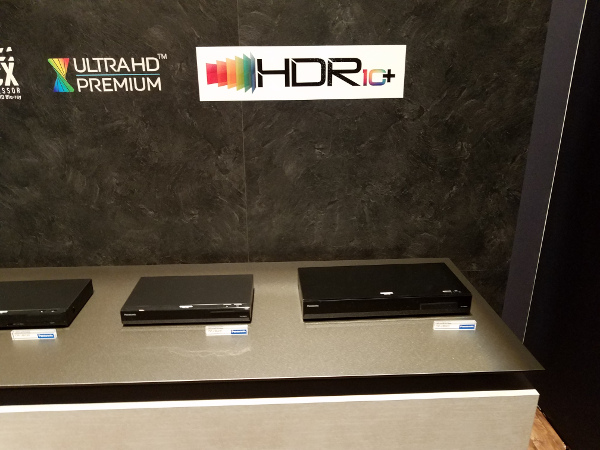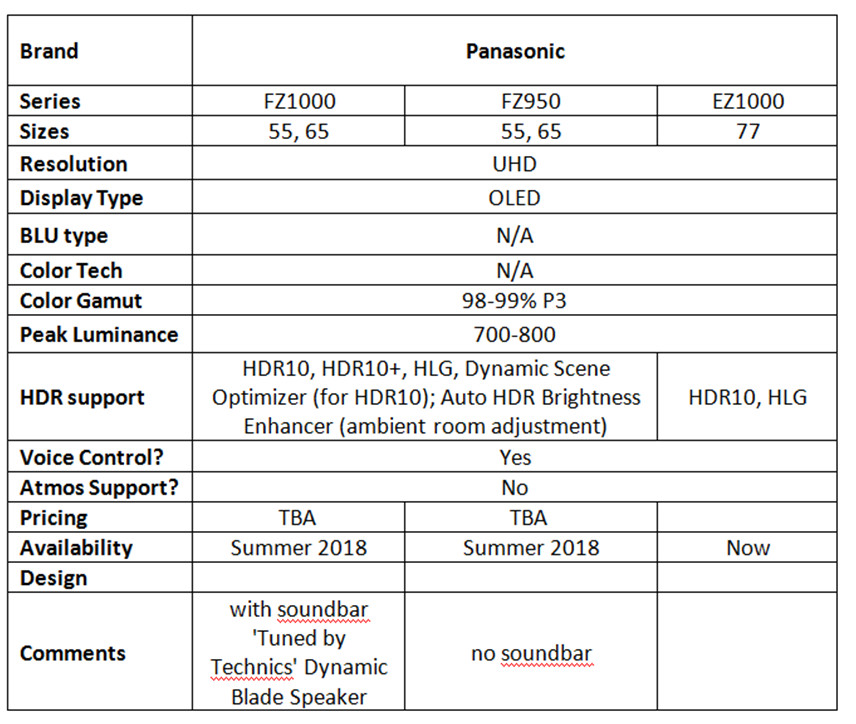Key Messages
Panasonic used its CES 2018 press conference to announce four new OLED TVs and to reinforce its support for the dynamic metadata HDR10+ standard. Panasonic is part of the HDR10+ consortium formed with Samsung and 20th Century Fox last IFA, and now supported by Warner Bros as well. Once the HDR10+ licensing program is open, the companies will incorporate HDR10+ technologies in all future Ultra HD movie releases, selected TVs, and Ultra HD Blu-ray players, and other products.
Panasonic North America Chairman/CEO Tom Gebhardt said its new OLED TVs, the FZ950 and FZ800 will support HDR10+ decoding and processing, allowing the streaming of HDR10+ content from Amazon upon purchase. A new HDR10+ Ultra HD Blue-ray player was announced as well.

These TVs will be sold worldwide except in the U.S. where they will only be sold as client review monitors for professional use. Panasonic exited the U.S. TV market a few years ago and did not announce any plans to re-enter it.
New Technologies/Upgrades
Panasonic is also very proud of its image processing technology developed in cooperation with Hollywood creative professionals working at Deluxe (and its leading post-production studios Company 3, EFILM and Encore). This is incorporated in the OLED TV’s SoC called the HCX 4K video processor. Deluxe has chosen to use Panasonic OLED TVs as “client reference monitors” meaning they are not used for color grading but are used to allow clients to see how their content will appear on the best consumer TVs allowing approval of the content.
For 2018 models, one big upgrade is the introduction of a completely new “Dynamic LUT” system. The more data points used in the LUT the more accurate a calibration and color reproduction the display is capable of. Often, external 3D LUTs are used in post-production to calibrate a display to a finer degree than would be possible using internal controls.
LG has gone to a 33x33x33 LUT with its alpha processor but Panasonic did not disclose the number of points used for calibration other than to say that different LUTs are loaded depending upon average brightness level of the scene. According to the company, this brings significant improvements to mid-brightness scenes, making them look much more natural. To improve color accuracy in shadows, Panasonic has included additional layers of LUT data at much darker levels than previously. This means that, while the transition from pure black is improved, the colors in the shadows are even more accurate.
Panasonic has also extended the range and reduced the interval between calibration steps at the darkest end of the RGB and gamma scales. This can be adjusted by the user via Panasonic’s Color Management System. The FZ950 and FZ800 support Imaging Science Foundation (ISF) calibration settings and new calibration points at 5% and, in an industry first, just 2.5% luminance, providing the greatest control where it is most needed: just above complete blackness in low-lit scenes. These industry-first calibration points will also be supported by Portrait Display’s CalMAN software with AutoCal functionality. Panasonic’s FZ950 and FZ800 are now CalMAN Ready.
All of this year’s new OLED screens also include an Absolute Black Filter, which helps ensure the purest, most accurate black levels by absorbing ambient light in order to eliminate reflections — especially beneficial in brightly lit rooms.
On the audio side, the FZ950 range features a ‘Tuned by Technics’ Dynamic Blade Speaker integrated into the set. With no fewer than eight multiple speaker units (four larger woofers, four squawkers, and two tweeters, plus a quad passive radiator to boost bass) and 40% increased volume, the Dynamic Blade Speaker was developed in conjunction with engineers from Technics, Panasonic’s audio brand.
HDR support includes HDR10, HLG and HDR10+, but not Dolby Vision. There is also a mode called Dynamic Scene Optimizer which uses picture analysis to mimic dynamic metadata when playing an HDR10 source. Furthermore, the new Auto HDR Brightness Enhancer function allows viewers to experience the optimal viewing experience by manually or automatically adjusting how HDR content looks in a brighter room.
OLED TVs
The 2017 EZ1000 OLED TV will continue for 2018 and will be joined by the FZ950 and FZ800. Like the EZ1000, Panasonic will seek to obtain UHD Alliance Ultra HD Premium certification as well as THX certification for these new sets. TV specifications are summarized below.



